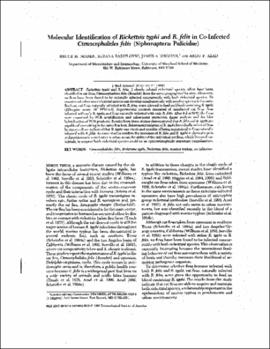| dc.contributor.author | Noden, Bruce H. | |
| dc.contributor.author | Radulovic, Suzana | |
| dc.contributor.author | Higgins, James A. | |
| dc.contributor.author | Azad, Abdu F. | |
| dc.date.accessioned | 2022-04-12T13:56:32Z | |
| dc.date.available | 2022-04-12T13:56:32Z | |
| dc.date.issued | 1998 | |
| dc.identifier | oksd_noden_molecularidentification_1998 | |
| dc.identifier.citation | Noden, B. H., Radulovic, S., Higgins, J. A., & Azad, A. F. (1998). Molecular identification of Rickettsia typhi and R. felis in co-infected Ctenocephalides felis (Siphonaptera: Pulicidae). Journal of Medical Entomology, 35(4), pp. 410-414. https://doi.org/10.1093/jmedent/35.4.410 | |
| dc.identifier.uri | https://hdl.handle.net/11244/335208 | |
| dc.description.abstract | Rickettsia typhi and R. felis, 2 closely related rickettsial species, often have been identified in cat fleas, Ctenocephalides felis (Bouche) from the same geographical location. However, no fleas have been found to be naturally infected concurrently with both rickettsial species. To examine whether one rickettsial species can develop simultaneously with another species in the same flea host, cat fleas, naturally infected with R. felis, were allowed to feed on blood containing R. typhi (Ethiopian strain, 107 PFU/ml). Experimental controls consisted of uninfected cat fleas, fleas infected with only R. typhi; and fleas naturally infected with only R. felis. After 9 d at 28 degrees C, the fleas were examined by PCR amplification and subsequent restriction digest analysis and dot blot hybridization of PCR products. Results from these studies demonstrated that R. felis and R. typhi are capable of co-existing in the same flea host. Subsequent isolation of R. typhi from dually infected fleas by tissue culture indicated that R. typhi was viable and capable of being maintained in fleas naturally infected with R. felis. As more studies confirm the presence of R. felis and R. typhi in domestic pets and peridomestic vertebrates in urban areas, the ability of the individual cat fleas, which live on these animals, to support both rickettsial species could be an epidemiologically important consideration. | |
| dc.format | application/pdf | |
| dc.language | en_US | |
| dc.publisher | Oxford University Press (OUP) | |
| dc.relation.ispartof | Journal of Medical Entomology, 35 (4) | |
| dc.relation.uri | https://www.ncbi.nlm.nih.gov/pubmed/9701920 | |
| dc.rights | This material has been previously published. In the Oklahoma State University Library's institutional repository this version is made available through the open access principles and the terms of agreement/consent between the author(s) and the publisher. The permission policy on the use, reproduction or distribution of the material falls under fair use for educational, scholarship, and research purposes. Contact Digital Resources and Discovery Services at lib-dls@okstate.edu or 405-744-9161 for further information. | |
| dc.subject.mesh | Animals | |
| dc.subject.mesh | Cats | |
| dc.subject.mesh | Rickettsia | |
| dc.subject.mesh | Rickettsia typhi | |
| dc.subject.mesh | Siphonaptera | |
| dc.title | Molecular identification of Rickettsia typhi and R. felis in co-infected Ctenocephalides felis (Siphonaptera: Pulicidae) | |
| dc.date.updated | 2022-04-07T14:53:59Z | |
| osu.filename | oksd_noden_molecularidentification_1998.pdf | |
| dc.description.peerreview | Peer reviewed | |
| dc.identifier.doi | 10.1093/jmedent/35.4.410 | |
| dc.description.department | Entomology and Plant Pathology | |
| dc.type.genre | Article | |
| dc.type.material | Text | |
| dc.subject.keywords | Vaccine Related | |
| dc.subject.keywords | Biodefense | |
| dc.subject.keywords | Prevention | |
| dc.subject.keywords | Emerging Infectious Diseases | |
| dc.subject.keywords | 06 Biological Sciences | |
| dc.subject.keywords | 11 Medical and Health Sciences | |
| dc.subject.keywords | Tropical Medicine | |
| dc.identifier.author | ORCID: 0000-0002-0096-370X (Noden, BH) | |
| dc.identifier.author | ScopusID: 6601968347 (Noden, BH) | |
| dc.identifier.author | ScopusID: 57194023662 (Radulovic, S) | |
| dc.identifier.author | ScopusID: 57213585907 (Higgins, JA) | |
| dc.identifier.author | ScopusID: 7102313565 (Azad, AF) | |
